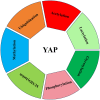YAP as a therapeutic target in esophageal squamous cell carcinoma: insights and strategies
- PMID: 40693409
- PMCID: PMC12284994
- DOI: 10.1080/07853890.2025.2536200
YAP as a therapeutic target in esophageal squamous cell carcinoma: insights and strategies
Abstract
Background: Yes-associated protein (YAP) is a core component of the Hippo pathway, which functions as an oncogene in various cancers. However, emerging evidence has shown that YAP can also act as a tumor suppressor. Therefore, understanding the function and molecular mechanism of YAP is crucial for developing YAP-targeted drugs in tumors.
Methods: A comprehensive literature review was conducted. The review mainly includes the post-translational modification, the regulatory mechanisms and function of YAP in esophageal squamous cell carcinoma (ESCC).
Results: YAP undergoes various post-translational modifications (PTMs), including phosphorylation, ubiquitination, acetylation and others, which critically regulate its protein stability and transcriptional activity in multiple tumors, particularly ESCC. YAP is highly expressed in ESCC tissues, with its aberrant activation closely correlated with poor prognosis in patients. Additionally, YAP is involved in the progression of ESCC, including tumor migration, invasion, proliferation, cell stemness, apoptosis, therapeutic resistance, and immunity. In ESCC, YAP has been confirmed to be regulated by multiple upstream regulators, such as E3 ubiquitin ligases and kinases, thereby influencing the ESCC progression. However, there are still few drugs available clinically for YAP-targeted therapy, which requires further research. In this review, we systematically synthesize the biological roles and regulatory mechanisms of YAP in ESCC and outline potential research directions for YAP-targeted therapies, aiming to provide novel insights for precision medicine in ESCC.
Conclusion: YAP is closely correlated to ESCC progression, and it could be a promising target for ESCC treatment.
Keywords: Esophageal squamous cell carcinoma; YAP; hippo pathway; therapeutic strategy.
Conflict of interest statement
No potential conflict of interest was reported by the author(s).
Figures






Similar articles
-
Molecular Mechanism of WWOX Inhibiting the Development of Esophageal Cancer by Inhibiting Hippo Signaling Pathway.Biochem Genet. 2025 Aug;63(4):3157-3169. doi: 10.1007/s10528-024-10856-9. Epub 2024 Jun 20. Biochem Genet. 2025. PMID: 38902482
-
WISP1 drives esophageal squamous cell carcinoma progression via modulation of cancer-associated fibroblasts and immune microenvironment.Front Immunol. 2025 Jul 23;16:1586790. doi: 10.3389/fimmu.2025.1586790. eCollection 2025. Front Immunol. 2025. PMID: 40771797 Free PMC article.
-
CircJPH1 regulates the NF-κB/HERC5 axis to promote the malignant progression of esophageal squamous cell carcinoma through binding to XRCC6.Cell Signal. 2024 Dec;124:111403. doi: 10.1016/j.cellsig.2024.111403. Epub 2024 Sep 8. Cell Signal. 2024. PMID: 39255925
-
METTL3-driven m6A modifications in esophageal squamous cell Carcinoma: Emerging mechanisms, biomarker potential, and therapeutic innovations.Eur J Pharmacol. 2025 Sep 5;1002:177785. doi: 10.1016/j.ejphar.2025.177785. Epub 2025 May 29. Eur J Pharmacol. 2025. PMID: 40449646 Review.
-
Complex roles of Hippo-YAP/TAZ signaling in hepatocellular carcinoma.J Cancer Res Clin Oncol. 2023 Nov;149(16):15311-15322. doi: 10.1007/s00432-023-05272-2. Epub 2023 Aug 22. J Cancer Res Clin Oncol. 2023. PMID: 37608027 Free PMC article. Review.
References
Publication types
MeSH terms
Substances
LinkOut - more resources
Full Text Sources
Medical
Miscellaneous
